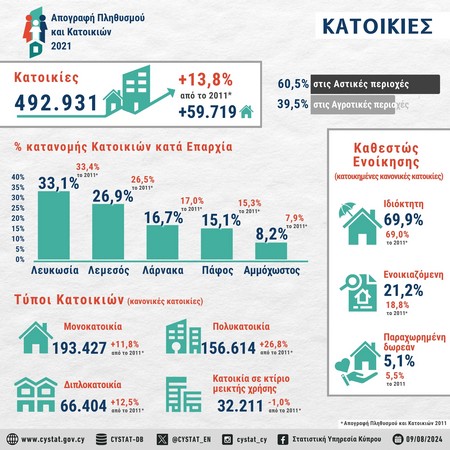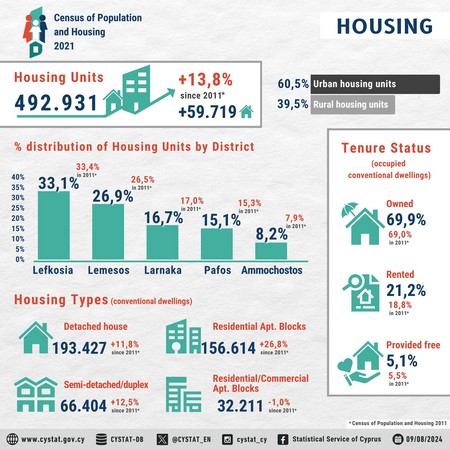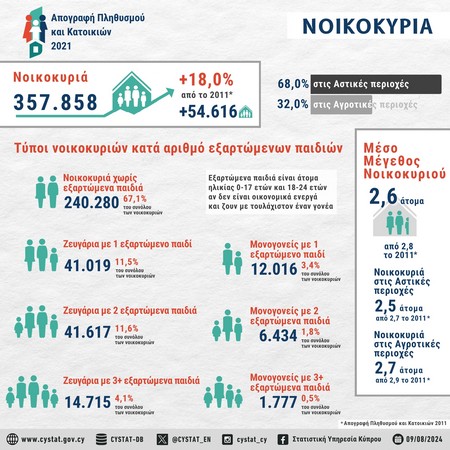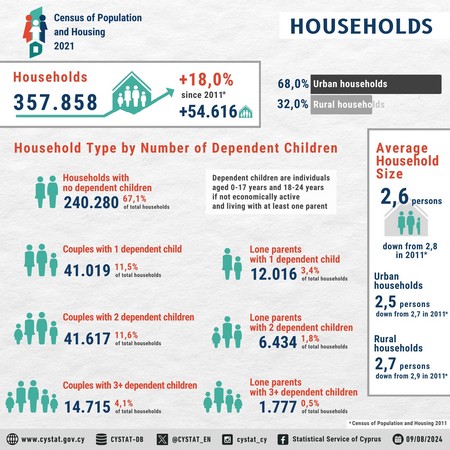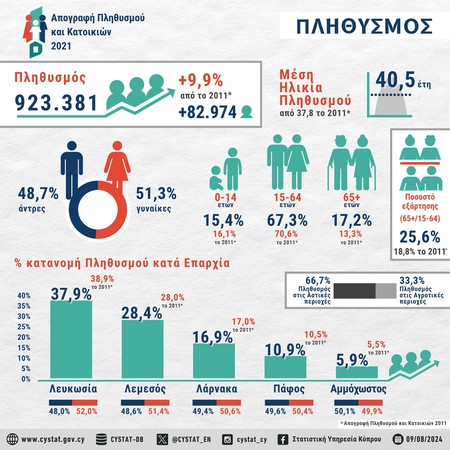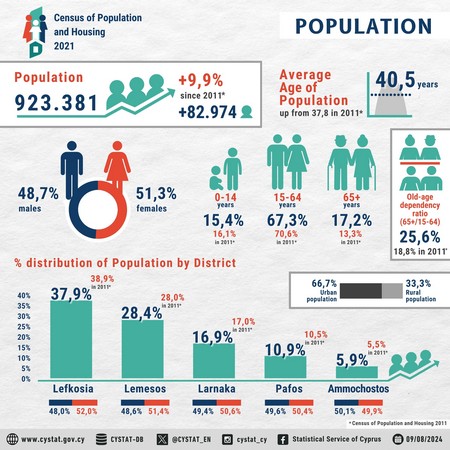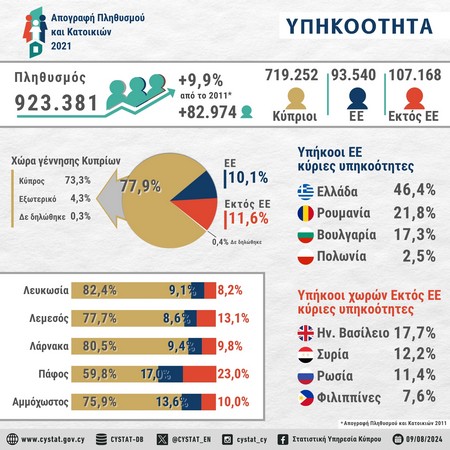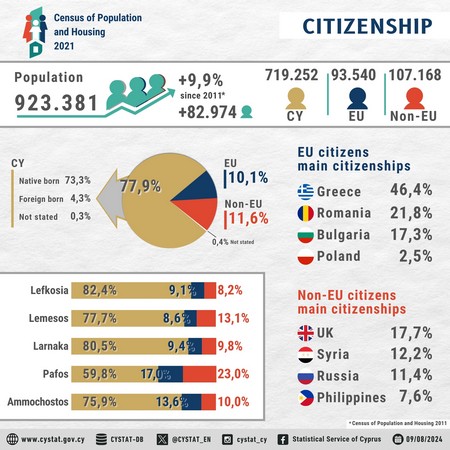Press Releases
09-08-2024 14:00
Census of Population and Housing 2021: Final Results
The Statistical Service announces the final results of the Census of Population and Housing 2021, which was conducted in the Government controlled areas of the Republic of Cyprus.
Population by Sex, Geographical Distribution and Age
According to the results of the Census of Population and Housing 2021, the total population in the Government controlled areas of the Republic of Cyprus on 1st October 2021 reached 923.381 persons, 449.708 males and 473.673 females, recording an increase of 9,9% compared to the results of the Census of Population and Housing 2011 in which 840.407 persons were enumerated, 408.780 males and 431.627 females.
A proportion of 66,7% of the population enumerated (615.603 persons) resided in urban areas, whereas 33,3% (307.778 persons) resided in rural areas. The corresponding percentages in the 2011 Census of Population were 67,4% (566.191) and 32,6% (274.216) respectively, thus indicating that a decrease in the population of rural areas was not observed, even though in some remote or mountainous communities some decrease in the number of residents was observed.
Τhe population distribution by district was as follows: 350.035 persons or 37,9% resided in Lefkosia District, 262.157 (28,4%) resided in Lemesos District, 155.765 (16,9%) in Larnaka District, 101.106 (10,9%) in Pafos District and 54.318 (5,9%) in Ammochostos District.

Compared to the results of the 2011 Population Census, the largest percentage population increase (16,5%) was recorded in Ammochostos District, followed by the Districts of Pafos (14,5%) and Lemesos (11,4%).
|
Table 1 |
|||
|
District |
Population |
||
|
1.10.2021 |
1.10.2011 |
% Increase 2021/2011 |
|
|
Lefkosia |
350.035 |
326.980 |
7,1 |
|
Ammochostos |
54.318 |
46.629 |
16,5 |
|
Larnaka |
155.765 |
143.192 |
8,8 |
|
Lemesos |
262.157 |
235.330 |
11,4 |
|
Pafos |
101.106 |
88.276 |
14,5 |
|
Total |
923.381 |
840.407 |
9,9 |
The percentage of persons aged less than 15 years reached 15,4%, the percentage of persons in the age group 15-64 years reached 67,3% and the percentage of persons aged 65 years and over reached 17,2%. The percentage of persons aged 65 years and over has exceeded the percentage of persons aged less than 15 years, indicative of the ageing of the population. The phenomenon of population ageing is observed in most European countries.
In the following figure, the age composition of the population during the last two Censuses is presented. The results display that the percentage of children, aged less than 15 years, has decreased from 16,1% in 2011 to 15,4% in 2021 and the percentage of persons aged 65 years and over has increased from 13,3% in 2011 to 17,2% in 2021.

Population by Citizenship and Country of Birth
As regards the population enumerated by citizenship, 719.252 persons or 77,9% were Cypriots, 93.540 (10,1%) were European Union (EU) citizens (except Cypriots), mainly from Greece (4,7%), Romania (2,2%) and Bulgaria (1,8%), while 107.168 persons (11,6%) were non-EU citizens, mainly from the United Kingdom (2,0%), Syria (1,4%) and Russia (1,3%).
The largest proportion of foreign citizens to the total population of the district is observed in Pafos District (40,0%), the second largest in Ammochostos District (23,6%), followed by Lemesos District (21,7%), Larnaka District (19,2%) and finally Lefkosia District (17,3%).

Of the total population enumerated, 688.844 persons or 74,6% were born in Cyprus, 86.026 or 9,3% were born in other EU countries, mainly Greece (3,8%), Romania (2,1%) and Bulgaria (1,8%), while 142.514 or 15,4% were born in non-EU countries, mainly the United Kingdom (3,0%), Russia (1,8%) and Syria (1,3%).

Population by Educational Attainment
The educational attainment of the population aged 15 years and over, which numbered 780.770 persons, was distributed as follows: 2,0% had not completed primary education, 11,6% had completed primary education, 9,7% had completed lower secondary education (Gymnasium), 36,6% had completed upper secondary education (Lyceum/Technical), 3,4% post-secondary non-tertiary, 6,0% tertiary level non-university and 27,6% tertiary - university level (19,8% first degree, 7,1% post-graduate degree and 0,7% doctorate).
The percentage of the population aged 15 and over with tertiary education (university level) has increased significantly. Specifically, this percentage has increased from 20,2% in 2011 to 27,6% in 2021. The percentage of females who have completed tertiary education (university level) is slightly higher (28,1%) than the corresponding percentage of males (27,1%). The corresponding percentages in 2011 were 20,2% for females and 20,3% for males.

Housing Units
Of the 492.931 housing units enumerated, 354.818 were of usual residence while 138.113 were vacant or of temporary residence. Regarding the geographical distribution of housing units, 298.020 (60,5%) were enumerated in urban areas and 194.911 (39,5%) in rural areas. A total of 163.350 (33,1%) were recorded in Lefkosia District, 132.574 (26,9%) in Lemesos District, 82.274 (16,7%) in Larnaka District, 74.473 (15,1%) in Pafos District, and 40.260 (8,2%) in Ammochostos District.

Compared to the results of the 2011 Census, Ammochostos District displays the largest increase in the number of housing units (17,9%) followed by Lemesos District (15,6%) and Lefkosia District (13,0%).
|
Table 2 |
|||
|
District |
Housing Units |
||
|
1.10.2021 |
1.10.2011 |
% Increase 2021/2011 |
|
|
Lefkosia |
163.350 |
144.556 |
13,0 |
|
Ammochostos |
40.260 |
34.150 |
17,9 |
|
Larnaka |
82.274 |
73.676 |
11,7 |
|
Lemesos |
132.574 |
114.662 |
15,6 |
|
Pafos |
74.473 |
66.168 |
12,6 |
|
Total |
492.931 |
433.212 |
13,8 |
The following figure displays the percentage distribution of housing units by district and urban/rural area.

Of the 492.931 housing units enumerated, 491.545 were conventional dwellings, meaning that they were constructed for habitation, while 1.386 were non-conventional dwellings, meaning that they were not built for habitation, however they were used as a place of residence by one or more persons, e.g. a commercial store that was used for habitation. Of the 491.545 conventional dwellings, 353.432 were occupied, of which 247.019 (69,9%) were owner-occupied, 74.809 (21,2%) were rented and 17.890 were provided for free (5,1%), while 12.397 (3,5%) had a different tenure status.

Households
A total of 357.858 households were enumerated in 2021 (compared to 303.242 in 2011), with average household size of 2,57 persons (2,76 in 2011), 2,51 in urban areas (2,70 in 2011) and 2,68 in rural areas (2,88 in 2011). Ammochostos was the district with the largest average household size (2,66) whereas Lefkosia was the district with the smallest (2,51). The largest increase in the number of households, compared to the 2011 Census, is recorded in Ammochostos District (29,1%), followed by Pafos District (20,0%).
|
Table 3 |
|||||
|
District |
Households |
||||
|
1.10.2021 |
1.10.2011 |
% Increase 2021/2011 |
Average Household Size 1.10.2021 |
Average Household Size 1.10.2011 |
|
|
Lefkosia |
137.805 |
119.203 |
15,6 |
2,51 |
2,73 |
|
Ammochostos |
20.424 |
15.826 |
29,1 |
2,66 |
2,94 |
|
Larnaka |
59.226 |
50.038 |
18,4 |
2,62 |
2,85 |
|
Lemesos |
100.806 |
85.171 |
18,4 |
2,59 |
2,75 |
|
Pafos |
39.597 |
33.004 |
20,0 |
2,55 |
2,67 |
|
Total |
357.858 |
303.242 |
18,0 |
2,57 |
2,76 |
A total number of 112.305 households (31,4%) comprised non-family households, 237.936 households (66,5%) were households with one family nucleus and the remaining 7.617 (2,1%) were households with two or more families. The corresponding percentages in 2011 were 25,3% non-family households, 72,4% one-family households and 2,3% households with two or more families.
Methodological Information
The purpose of the Census of Population and Housing 2021 was the complete and accurate geographical coverage of housing units, institutions, households and individuals, Cypriot and foreign nationals, who had their usual residence in the Government controlled areas of the Republic of Cyprus on the 1st of October 2021.
The Census constitutes a main source of information and of statistical data and is usually conducted every 10 years. It is the most costly and demanding project conducted by the Statistical Service. The previous Census of Population was conducted in 2011.
Data Collection Method
According to the original planning, the collection of data would have been carried out through personal or telephone interviews with households (traditional method), with the use of tablets, or with the completion of paper questionnaires by the respondents themselves.
A total of 1.000 enumerators would be responsible for the collection of data in all districts. Due to the fact that there was not enough interest from candidates, a much lower number of enumerators was employed, having a negative impact on the timeframe of the Census. Furthermore, the exceptional conditions and the restrictions that were in place during autumn 2021 due to the coronavirus pandemic (COVID-19) constituted another factor that inhibited the smooth development of the project, thus setting the completion of the Census outside the initially planned deadline (end of December 2021).
In order to complete the project, it was therefore necessary to modify the initial method of data collection. In particular, the new methods adopted involved the use of administrative data as additional sources of information as well as the use of modern technology. The administrative sources used for this purpose, following the approval by the Commissioner for Personal Data Protection, provided information on the main demographic characteristics of the population, such as the place of residence, sex, age, citizenship etc. These sources mainly included the Health Insurance Organisation Beneficiaries data base, the Births Register, the Deaths Register as well as the Population Register.
The results were obtained both from the collection of data using the traditional method, achieving a coverage of 80% of the population, and from administrative sources to cover the remaining population. With the use of administrative sources, full population coverage was achieved. In order to complete the missing information for certain variables, the statistical method of item imputation was employed.
The use of administrative sources for the purpose of conducting the Population Census is a methodological approach broadly used in many European countries for some years now. According to the latest information available, a proportion of 38% of EU countries has chosen to conduct the Census of Population 2021 exclusively from administrative sources, whereas an equally significant proportion of countries (35%) has chosen to use both the traditional Census and the use of administrative sources (combined Census). The traditional method of data collection with interviews is still used by 27% of EU countries.
The aim of the Statistical Service is that the database which has resulted from the Census of Population and Housing 2021 develops into a Dynamic Statistical Population and Housing Register, which will be updated on an ongoing basis from various administrative sources. As a result, it will no longer be necessary to conduct a door-to-door Population Census, covering the total population. The Dynamic Statistical Population and Housing Register will be the basis for the production of annual population data and demographic indicators, providing timely information that will facilitate state policy and planning.
Legal Framework and Data Protection
The Census of Population 2021 was conducted in all EU Member States, following common concepts and definitions, under Regulation (EC) No. 763/2008 of the European Parliament and of the Council of 9 July 2008 on population and housing censuses. The Census in Cyprus was also conducted in accordance to the Official Statistics Law of 2021 (Law No. 25(Ι)/2021). Based on the provisions of the Law, the data collected are treated as confidential and are used solely for statistical purposes.
Statistical confidentiality is strictly applied by the Statistical Service. The internal procedures resulting from the application of statistical confidentiality fully cover the provisions of the General Data Protection Regulation (GDPR) of the EU, ensuring the protection of data at every stage, from collection to publication. All data collected are aggregated and disseminated without directly or indirectly revealing the identity of the persons who provided the data.
Definitions
Population: Persons who had their usual residence in Cyprus on 1st October 2021, i.e. persons who resided permanently in Cyprus for one year or longer, or persons who had come to Cyprus during the last twelve months, prior to the reference date of the Census, with the intention of residing in Cyprus for a period of at least one year.
Housing Unit: A housing unit is separate and independent, and it has been built/rebuilt/converted with the intention to be used as the usual residence of one or more households, or if it was not originally intended for habitation, it was in fact used for that purpose on the reference date of the Census, e.g. a shop which was used by someone as his/her usual residence. Dwellings which were originally intended for habitation, yet on the reference date of the Census were used exclusively for other purposes and not for habitation, e.g. a conventional dwelling which was used as a company’s office, a laboratory etc., were not considered as housing units and were not enumerated.
Conventional Dwelling is defined as a room or suite of rooms in a permanent building which, by the way it has been built/rebuilt/converted, is designed for habitation by one or more households all the year round and is not, at the time of the Census, used wholly for non-residential purposes. It should have direct access to the street, either via a garden or grounds or a common space within the building (staircase, passage, gallery etc.) The conventional dwellings were enumerated regardless of whether or not they were occupied on the reference date of the Census, (unless they were used for non-residential purposes, in which case they were not enumerated).
Non-Conventional Dwelling: This is a housing unit which was either built with the intention of habitation, however it was built out of crude materials (and consequently is not included in the category of conventional dwellings), or it was not originally intended for habitation but it was nevertheless used for this purpose on the reference date of the Census, e.g. a shop which was used by someone for habitation. The non-conventional dwellings were enumerated only if they were inhabited (as a place of usual residence by one or more persons) on the reference date of the Census.
Household: A household comprises one or more persons, irrespective of relationship, who live together in the same housing unit, have common catering arrangements and share at least one main meal a day. A household could fall under one of the following two cases:
(a) Two or more persons living together, who have common catering arrangements and share at least one main meal a day. A household may comprise only members who are related to each other, or only members who are not related to each other, or by a combination of these two cases.
(b) Every person who resides alone in a separate housing unit, or who resides with other persons in a housing unit but who is not related to them, i.e. does not share meals with them, so as to be considered as a member of their household.
In the majority of cases, the terms household and family (or family nucleus) are identical, i.e. a household comprises one family. There are cases, however, in which the definition of a household is broader than that of the family, e.g. a household may comprise a father, mother, children and grand-parents.
Tenure Status: This refers to whether the housing unit is owner-occupied, rented, of free lodging or if another form of tenure status applies.
a) Owner-occupied: The housing unit belongs to one of the members of the household.
b) Rented: The tenant of the housing unit (or some other person or company etc.) pays rent to the owner of the housing unit.
c) Provided for free: This refers to the case where the housing unit is offered for free lodging to relatives or other persons, without the person residing in the housing unit having to pay rent to the owner).
d) Other tenure status: This refers to the cases where the tenure status cannot be described by one of the previous categories.
Country of birth: The country in which the respondent’s mother had her usual residence when she gave birth to him/her was recorded as the respondent’s country of birth. The same definition applied for the country of birth of the father and of the mother of the respondent.
Citizenship: The respondent was asked of his first and second citizenship, if this applied. The persons who had stated the Cypriot citizenship as either their first or second citizenship are presented in the relevant tables as Cypriots. The persons who had stated two citizenships, one of an EU country (except the Republic of Cyprus) and the other of a non-EU country, are presented in the relevant tables as EU citizens.
Educational Attainment: For each respondent who was 15 years of age or older, the highest level of education which s/he had completed on the reference date of the Census, was recorded.
Family Nucleus is defined as two or more persons within a household who are related as husband and wife, as cohabiting partners, or as parent and child. Thus, a family nucleus comprises a couple without children, a couple with one or more children, or a lone-parent family (a lone-parent with one or more children).
For further information, please visit the CYSTAT Portal, theme Population, CYSTAT-DB (Online Database), Predefined Tables, Methodological Information or contact Ms Loukia Makri at 22602150 or via email at lmakri@cystat.mof.gov.cy, Ms Georgia Ioannou at 22602144 or via email at gioannou@cystat.mof.gov.cy, and Ms Koulia Onisiforou at 22602139 or via email at konisiforou@cystat.mof.gov.cy.
(MS/ΝGian)
Relevant Press Releases

03-04-2025 14:22
Consumer Price Index (CPI): March 2025

28-03-2025 18:12
European Statistics Competition, National Phase

28-03-2025 15:13
Industrial Production Index: January 2025

27-03-2025 21:02
Imports, Sales and Stocks of Petroleum Products: February 2025

21-03-2025 18:35
Household Budget Survey: 2023

